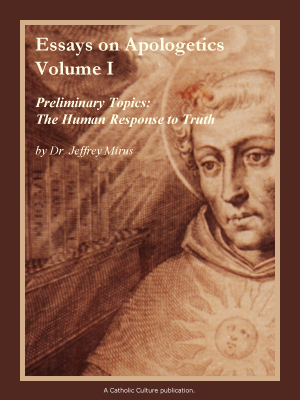Evangelization, Apologetics, and the Incarnational Difference
By Dr. Jeff Mirus ( bio - articles - email ) | Nov 22, 2013
One of the most striking things about the constant call for a new evangelization is that it represents such a sea change from the prevailing attitudes in both the immediate pre-Vatican II and the immediate post-Vatican II Church. It’s as if our sense of the Faith has finally clicked into place, and the whole “spiritual machinery” of our lives is beginning to turn again. Once again, the Faith has begun to seep into our bones so that it can find expression across the whole range of our human nature. Once again, the Faith is being perceived and expressed in incarnational terms.
Short of Our Lord’s Resurrection, there was nothing that He did as man on earth that was beyond the power of human nature infused with grace. His miracles, for example, have been performed again either through charismatic grace or the sacramental power of the Church. How much more does this apply to the wonderful manifestation of the Divine life in everything He said and did as a man—in all the ordinary human things which can be informed by grace without resorting to the term “miracle” at all.
Insofar as we have all sinned, this wonderful integration of body, soul and Spirit is not manifested perfectly by any one of us. In a similar way, it is not manifested perfectly in the societies and cultures we form, nor even in the Church herself, which in this life must divulge her very real glory through the veil of her members. But all of us, along with the social orders and cultures we create, and the Church herself, are called to achieve the deepest and most comprehensive integration we can. Catholicism is not to be compartmentalized or distorted in us, so that it has only a partial grip, or a very tenuous grip, or no real grip at all on how we live and move and have our being (Acts 17:28).
The last few generations have marked a particularly difficult time of compartmentalization and distortion. Of course, the experience of individuals varies greatly in each period; one can only characterize particular periods in terms of generalities. But there was a deep need for renewal in the Church by the mid-20th century because so many, from top to bottom, had come to live the Catholic life prescriptively. By 1950 in the West, the predominant Catholic habit was to find a certain spiritual comfort in those external forms and requirements which were easily enumerated for “the practicing Catholic” (sometimes tellingly referred to as the “practical” Catholic). Too few were plumbing the depths of the spiritual life (though, surely, there are always too few in every age).
The result was that when the culture began to secularize rapidly and the identifiable rules and customs began to change, the Church was swept to near ruin. Amid the standard practices—the liturgy, the holy water, weekly Mass attendance and monthly confession, regular contributions, the major feasts, the fasting and abstinence and ashes—Catholicism was largely taken for granted. To illustrate with just one example, consider that during the time of cultural transition, countless “good Catholic” families sent their kids off to a whole series of collapsing Catholic colleges and universities. What we found very quickly was that the kids hadn’t the least spiritual clue that they were being led wildly astray, and the parents had no clue about what was happening at all.
The problem was revealed in the crisis which followed. A pervasive spiritual rot came to the surface at every level of the Church except where her prerogatives were infallibly guaranteed. Huge numbers of Catholics, clergy and laity alike, responded to the growing secularization with a kind of crazy euphoria about the possibilities of identifying Christianity with the predominant social interests of the larger culture. People really did think that if they stopped worrying about the old questions of Catholic identity, everybody could agree on grand moral imperatives, such as racial equality and the elimination of poverty. People really did take cover in the rhetoric of secular sweetness and light, concluding that the messy details of the Faith could be glossed over or reinterpreted in terms of the spirit of the times.
In a sense, then, the Church in 1950 had an external identity without much of a theory to go with it, and the Church in 1975 substituted a theory without much of an identity. The problem in both mini-eras was that priests and people alike lacked what we might call “spiritual bottom”. In Christian humanist terms, they had disintegrated. They just didn’t see that the Incarnation of Jesus Christ changed everything in an integral way: Body, mind and soul.
A Sea Change?
The Catholic rhetoric of our time is very different, and I think that means something. The constant calls at every level for a new evangelization indicate, at long last, an awareness that there is something distinctive about the Christian message which is supposed to transform the whole person, not to mention the social order, human culture and the Church herself. There is a Gospel identity which is supposed to underlie everything we do, and which will accordingly change how we pray, how we think, how we speak, how we act and how we live.
This was brought home to me today by our news story about a recent address given by Archbishop Augustine Di Noia, the Assistant Secretary of the Congregation for the Doctrine of the Faith. Consider this one sentence alone: “We need a confident, evangelizing spirit and robust but not overbearing apologetics.” What Di Noia is saying is that Christian life is rooted in a very concrete message, a message which must be not only proclaimed with confidence (evangelization) but carefully explained and defended (apologetics). He then goes on to warn against viewing or living Christianity as some sort of sentimental comfort:
The emotional sense the Christian faith creates is rooted in convictions, principally that God wants to make a place for us in the life of the Blessed Trinity and that Jesus Christ opens the way to this communion and that our transformation into his image gets us through the muddle of sin but also launches us into the life of glory.
This is put extraordinarily well, and I note that it profoundly represents the Incarnational sense of the Faith which is growing so rapidly again today, a deeper grasp of the Faith that really can attract and transform the whole person. Put in terms of a popular expression, whether “your father” was at his Catholic peak in 1950 or 1980, this is simply no longer your father’s Church.
God knows we have a long way to go. But it makes all the difference to be headed in the right direction. It makes all the difference to live the faith incarnationally, in both the Church and the world. It makes all the difference to start with the one inescapably concrete and even scandalous reality—the very hallmark of the Spirit of God—that “Jesus Christ has come in the flesh” (1 Jn 4:2).
All comments are moderated. To lighten our editing burden, only current donors are allowed to Sound Off. If you are a current donor, log in to see the comment form; otherwise please support our work, and Sound Off!
-
Posted by: koinonia -
Nov. 24, 2013 9:29 AM ET USA
Archbisop's Di Noia's words are well-put and concise. We are called to be saints; we are indelibly marked as such by the miracle of baptism. Much of what was lost in the liturgy in particular is the meaning behind that which was prescribed. Today there is a rediscovery. The scandal of Christ crucified is ridiculous unless it truly affords men the opportunity to share in this "life of glory" in communion with the Blessed Trinity. This is the enduring philanthropy of Christ's Mystical Body.








